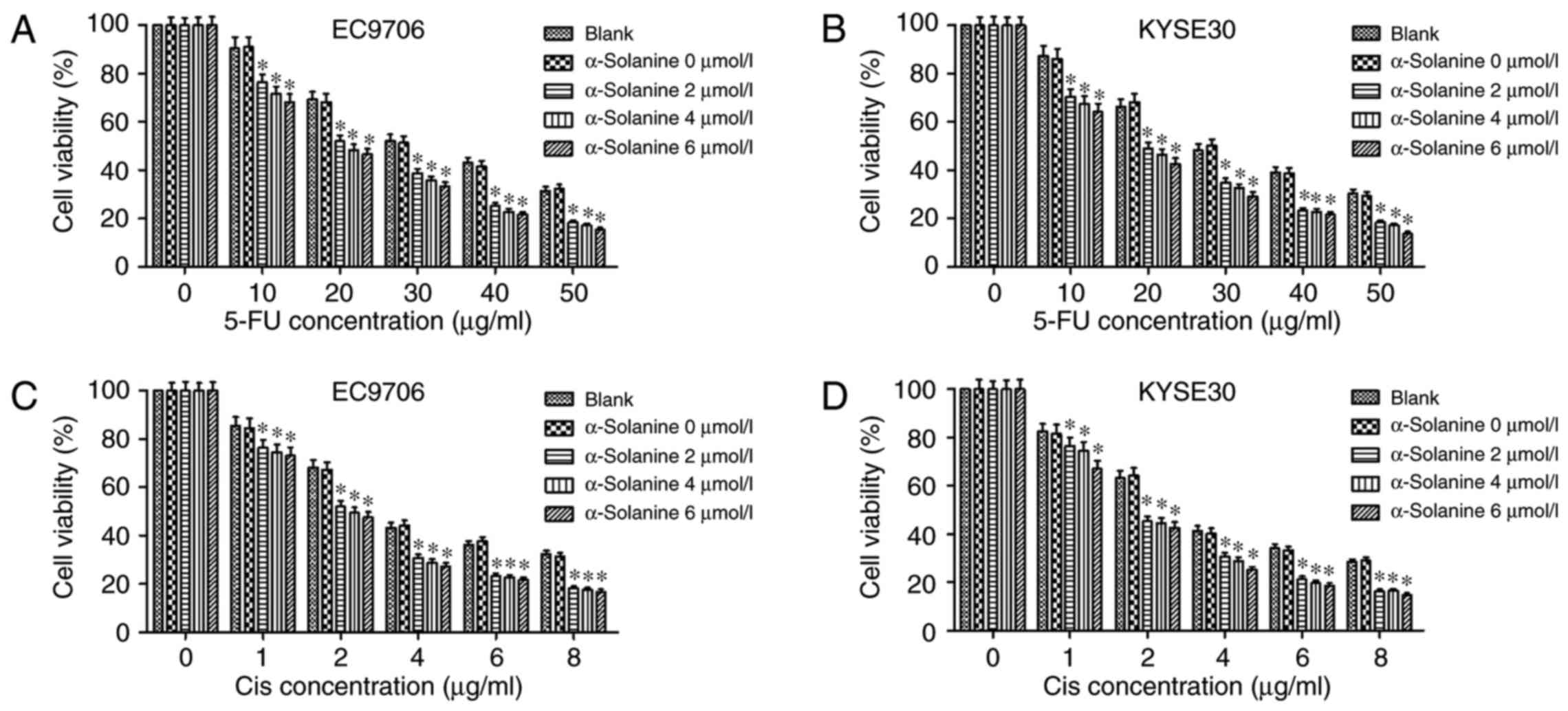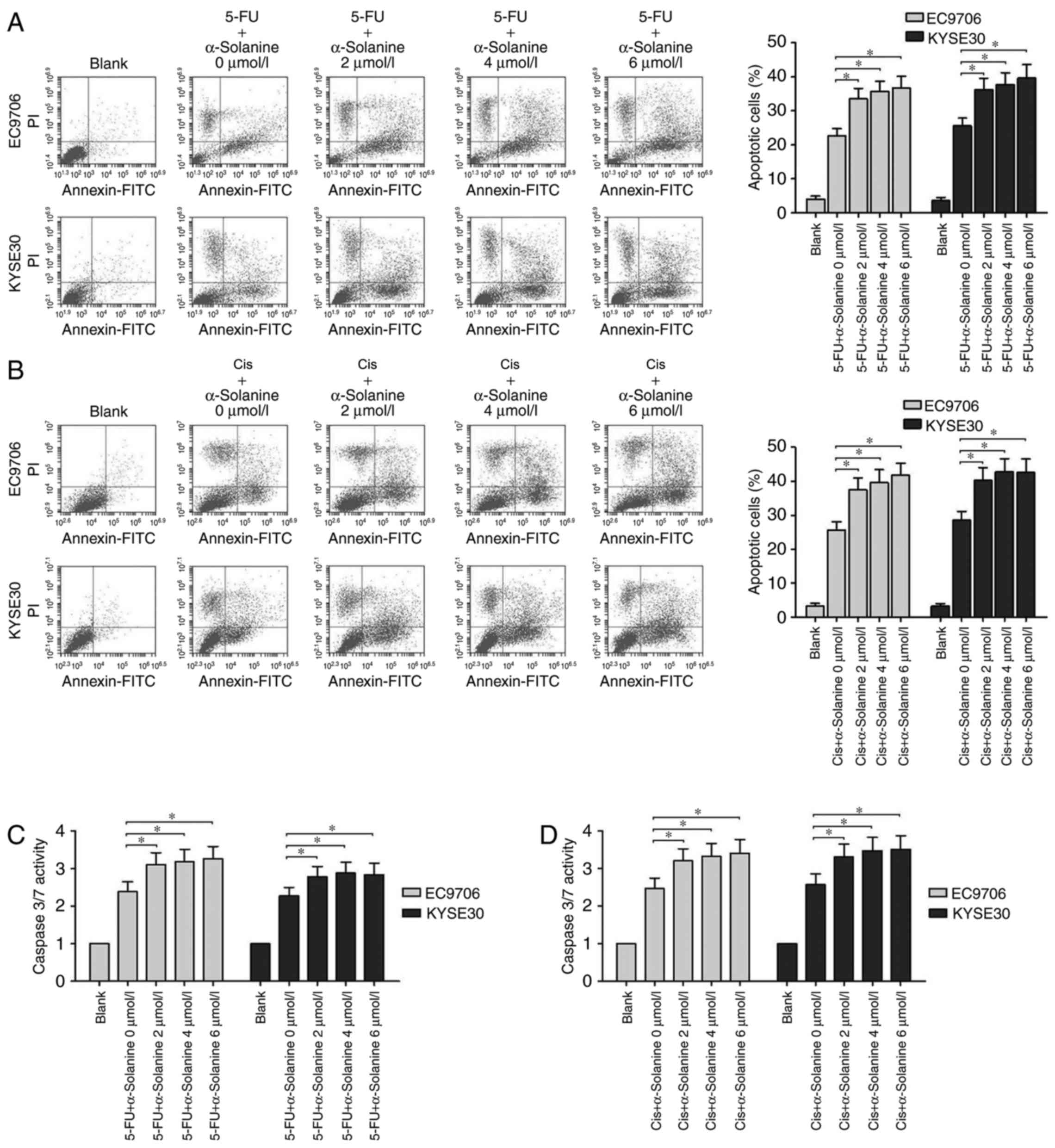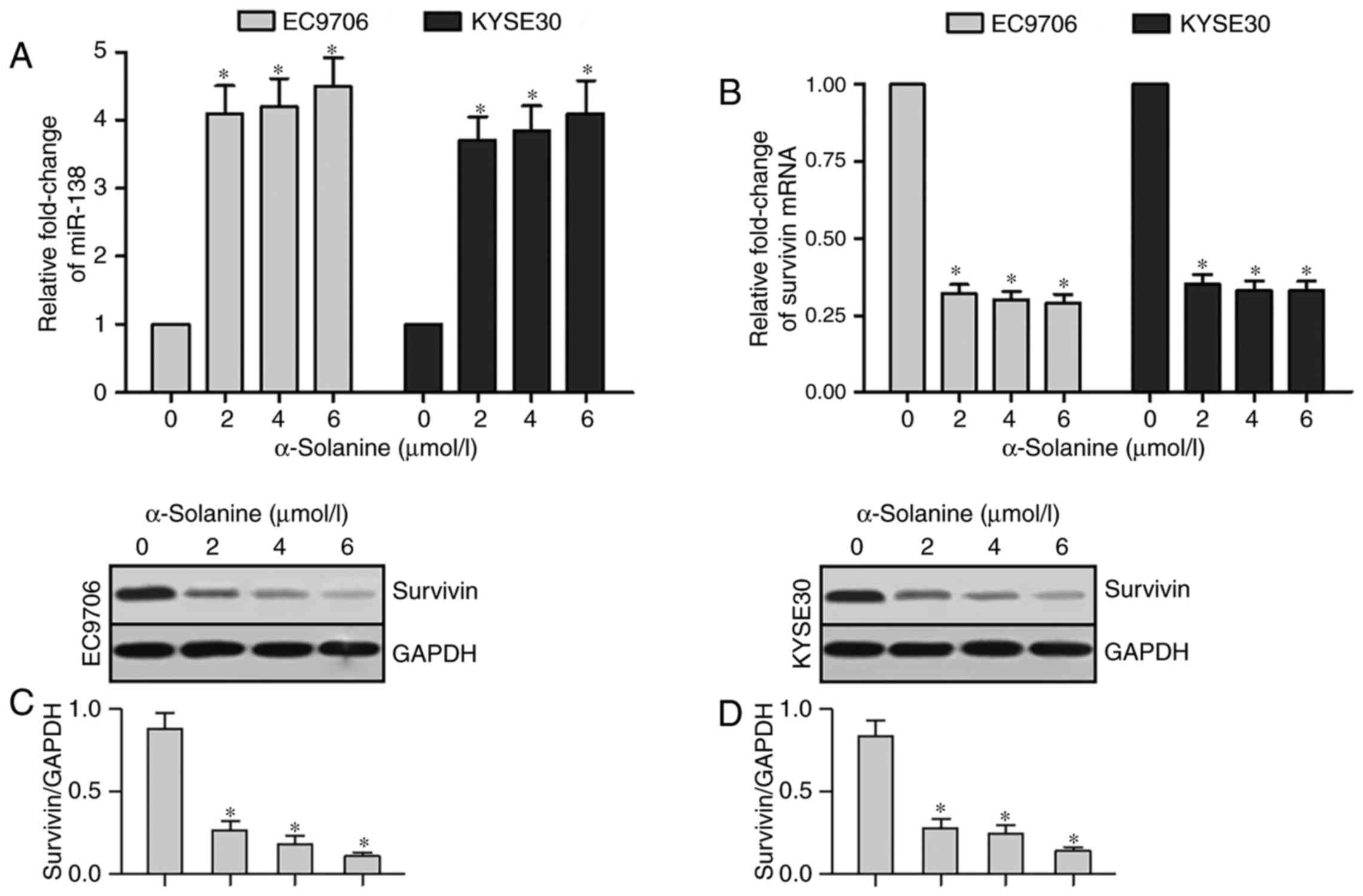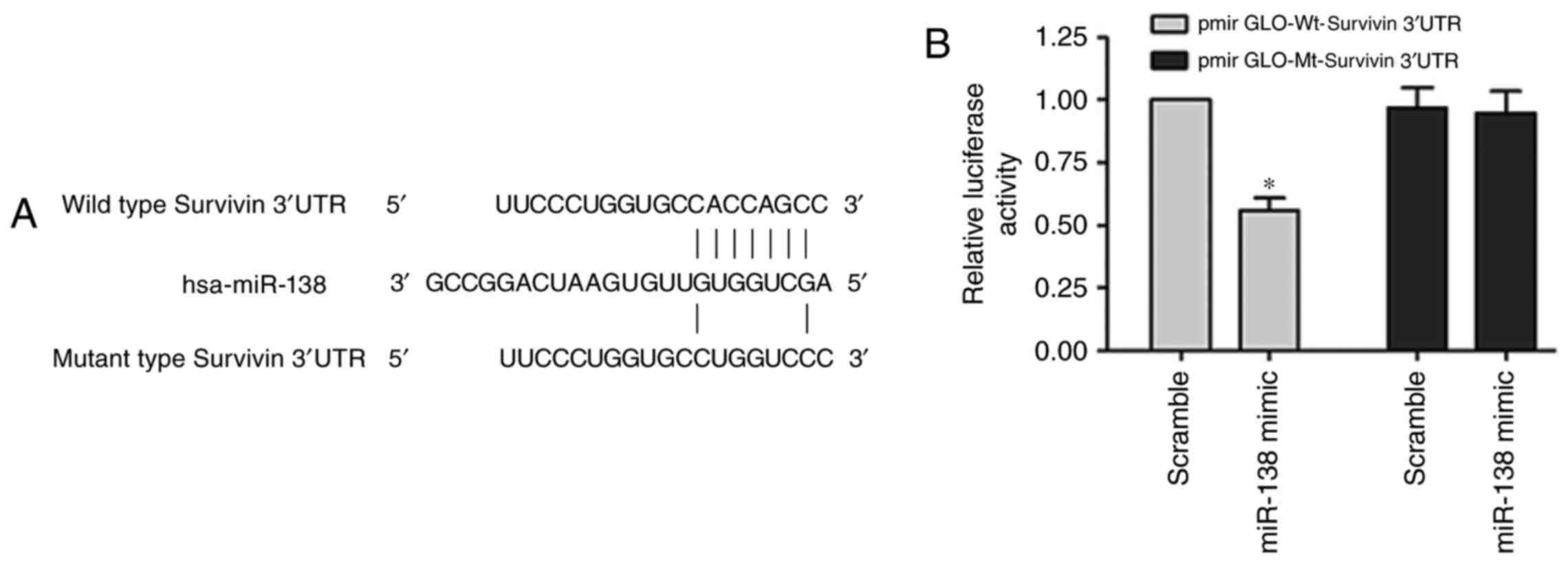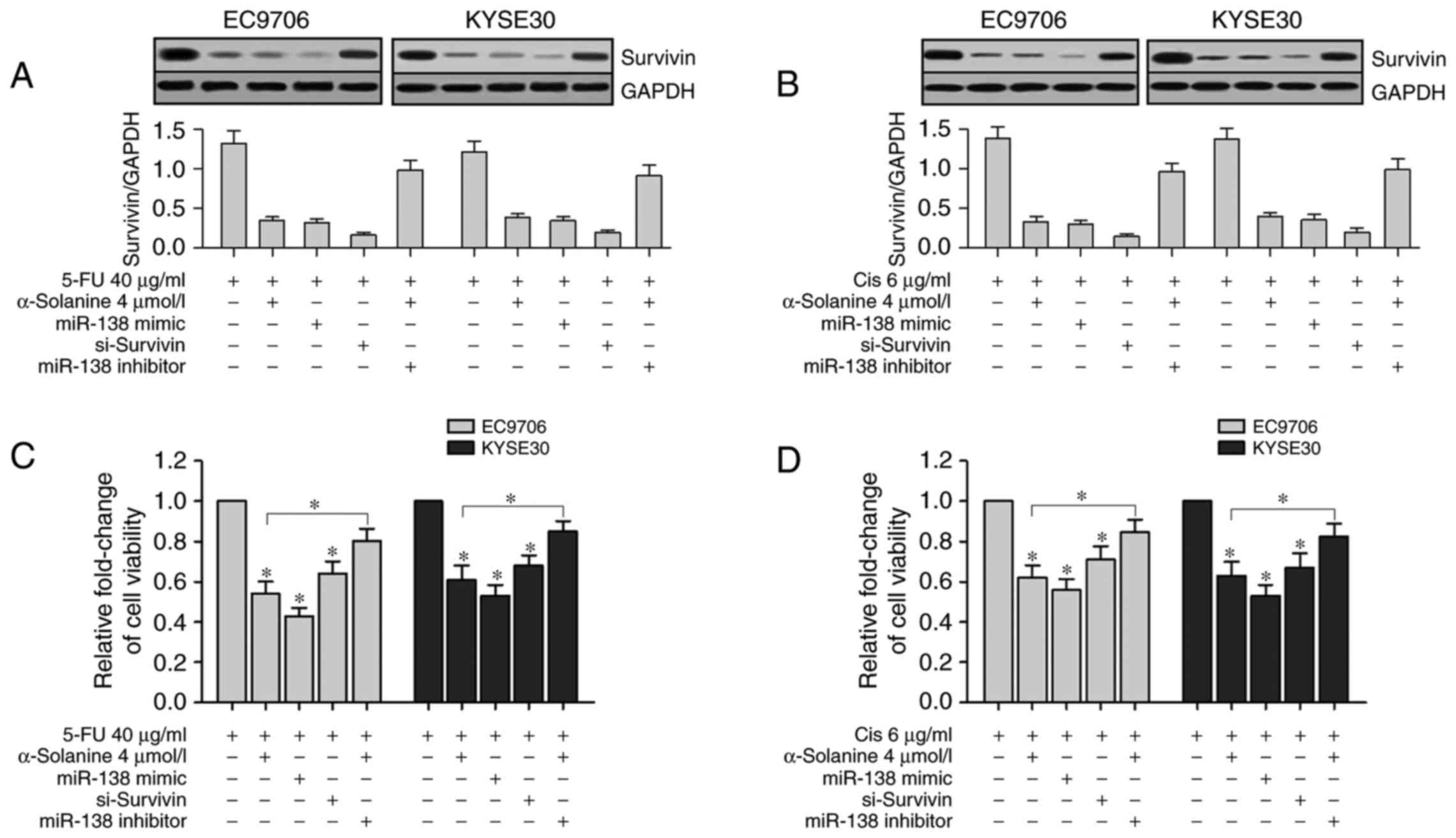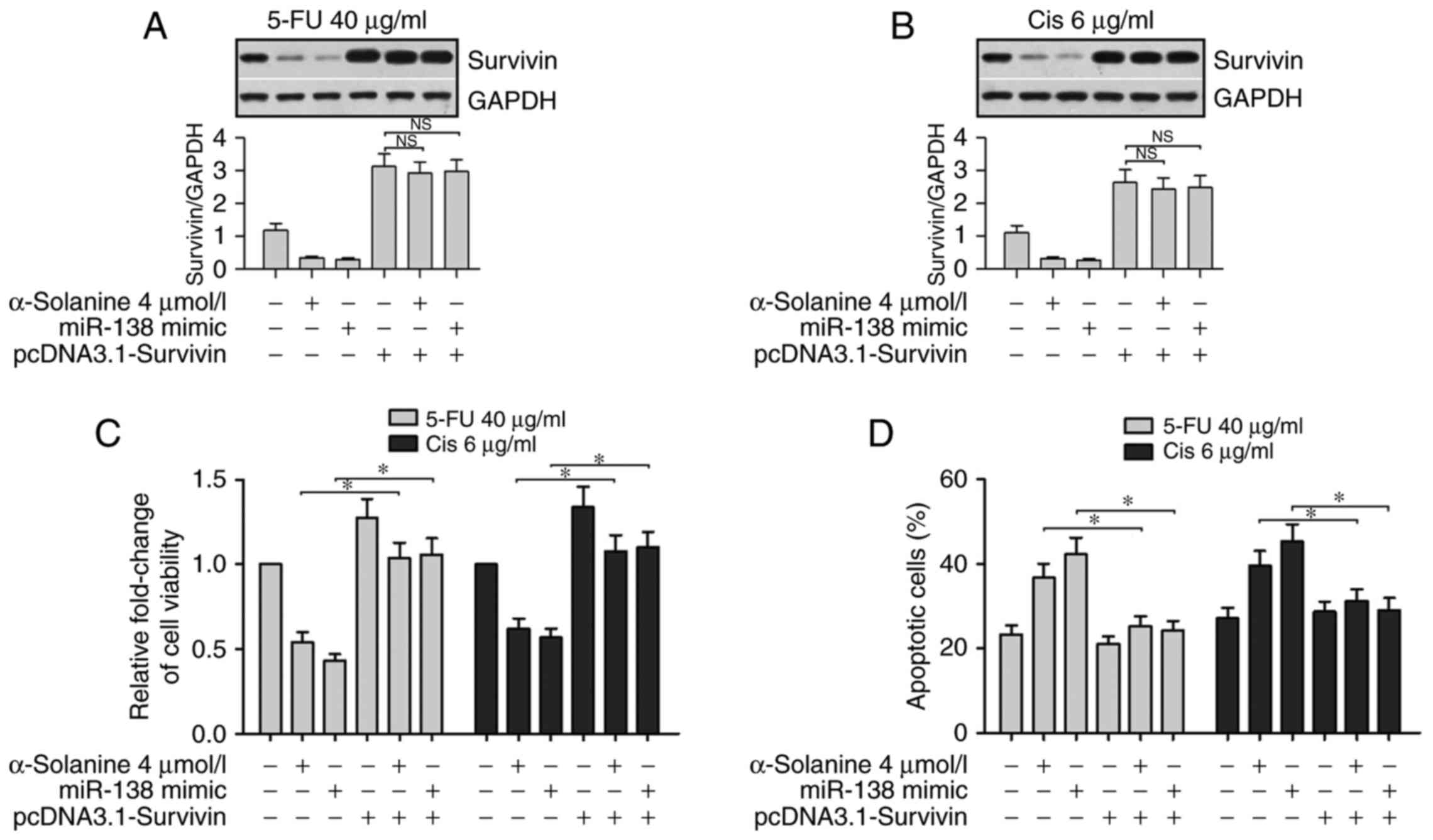α-solanine enhances the chemosensitivity of esophageal cancer cells by inducing microRNA‑138 expression
- Authors:
- Published online on: January 4, 2018 https://doi.org/10.3892/or.2018.6187
- Pages: 1163-1172
Abstract
Introduction
Esophageal cancer is the eighth most common cancer worldwide and the sixth leading cause of cancer-related mortality (1). Esophageal cancer is generally diagnosed at an advanced stage and has a dismal prognosis with a 17% 5-year overall survival rate (2). Currently, 5-fluorouracil (5-FU) and cisplatin (Cis) are the mainstays of chemotherapy available for the treatment of advanced esophageal cancer. However, the anticancer effects provided by these chemotherapeutic agents are often unsatisfactory. The response rates to Cis combined with 5-FU are only 35–45% (2), and drug resistance can be inherent or acquired during prolonged treatment. Due to the toxic effects of traditional chemotherapy, an escalated dosage often results in intensive adverse effect or even fatal outcomes. Therefore, to date, efforts have focused on the cellular and molecular mechanisms of the resistance phenotype to develop more effective anticancer strategies.
Drug resistance in cancer cells is a multifactorial phenomenon. Alterations of various molecules involved in DNA damage repair, apoptosis induction and drug distribution have been confirmed to contribute to the drug-resistance phenotype in cancer cells (3). Among these molecules, survivin has drawn interest from researchers due to its critical roles in apoptosis inhibition and drug resistance induction (4–7). As an inhibitor of apoptosis protein (IAP) family member, survivin can inhibit apoptosis via intrinsic and extrinsic pathways (5). At the same time, survivin enhances the survival of cells through its roles associated with various cellular signaling pathways (8,9). Overexpression of survivin can be found in most cancer cell types (including esophageal cancer cells) and confer drug-resistance to cancer cells (10–12). Currently, survivin is considered as an important therapeutic target in anticancer research.
The use of small-molecule anticancer compounds to prevent or treat cancers is a novel idea (13–15). α-solanine, one component of steroidal glycoalkaloids, is mainly found in the potato tuber or the nightshade plant. Several studies have shown that α-solanine demonstrates anti-metastatic activity in different types of cancers (16–19) and chemoprotective and chemotherapeutic effects in animal models of breast cancer (20). In our previous study, we found that α-solanine modulated the radiosensitivity of esophageal cancer cells by inducing miR-138 expression (21). Therefore, α-solanine may have effects on the chemosensitivity of esophageal cancer cells. In the present study, we investigated the effect of α-solanine on the chemosensitivity of EC9706 and KYSE30 cells to 5-FU and Cis and explored the potential molecular mechanisms.
Materials and methods
Cell culture and reagents
α-solanine and its solvent, dimethyl sulfoxide (DMSO), were purchased from Sigma-Aldrich (St. Louis, MO, USA). α-solanine was stored at −20°C after dissolution. Human esophageal cancer cell lines (EC9706 and KYSE30) were purchased from the Type Culture Collection of the Chinese Academy of Sciences (Shanghai, China). The cells were maintained in RPMI-1640 medium supplemented with 10% fetal bovine serum (FBS; Gibco BRL, Gaithersburg, MD, USA) and incubated in a 5% CO2 humidified incubator at 37°C.
CCK-8 assay
EC9706 and KYSE30 cells in logarithmic phase growth were seeded into each well of a 96-well plate at a density of 1×104 cells/well. After 24 h, cells of each cell line were treated with increasing concentrations (0, 2, 4 and 6 µmol/l) of α-solanine combined with increasing concentrations (0, 10, 20, 30, 40 and 50 µg/ml) of 5-FU or increasing concentrations (0, 1, 2, 4, 6 and 8 µg/ml) of Cis, respectively, for 24 h. The blank group was treated with PBS, and the control group was treated with 0 µmol/l α-solanine containing 1‰ DMSO. The viability of cells was determined according to the protocol included in the Cell Counting Kit-8 (CCK-8; Dojindo Laboratories, Kumamoto, Japan). Cells were cultured at 37°C in 5% CO2 for another 3 h with medium inclusion with 10% CCK-8, and then the optical density was measured at 450 nm. The experiments were performed in triplicate.
Flow cytometric assay
Apoptosis was analyzed by flow cytometric assay. Flow cytometric assays were conducted using FITC Annexin V Apoptosis Detection Kit I (BestBio, Shanghai, China), according to the manufacturer's instructions. Briefly, EC9706 and KYSE30 cells were cultured in a 96-well plate, in which the medium was added with different concentrations of α-solanine (0, 2, 4 and 6 µmol/l) with or without 40 µg/ml 5-FU or 6 µg/ml Cis for 48 h. The cells were divided into a Blank group (treated with PBS containing 1‰ DMSO), additional treatment groups (treated with 40 µg/ml 5-FU or 6 µg/ml Cis and different concentrations of α-solanine), and the control group treated with 40 µg/ml 5-FU or 6 µg/ml Cis with PBS containing 1‰ DMSO. Cells from each group were harvested by trypsinization and re-suspended at a density of 1×106 cells/ml in 1X binding buffer. After double staining with FITC Annexin V and propidium iodide (PI), cells were analyzed using a FACScan flow cytometer (BD Biosciences, Franklin Lakes, NJ, USA) equipped with CellQuest software (BD Biosciences).
Detection of caspase-3/7 activity
The enzymatic activity of caspase-3/7 was measured using the Caspase-Glo 3/7 assay kit (Promega, Shanghai, China) according to the manufacturer's instructions. In brief, EC9706 and KYSE30 cells were seeded in 96-well plates and treated with or without 40 µg/ml 5-FU or 6 µg/ml Cis and different concentrations (0, 2, 4 and 6 µmol/l) of α-solanine for 48 h; the Blank group was treated with PBS containing 1‰ DMSO. Then, the cells were lysed and incubated with 100 µl of Apo-ONE Caspase-3/7 reagent (substrate and buffer in the ratio of 1:100). After a one hour incubation in the dark at room temperature (RT), the fluorescence of each well was measured at 485–520 nm by reading in an Epoch microplate reader (Biotek Instruments, Winooski, VT, USA).
In vivo tumor growth assay
EC9706 cells (5×106), which were labeled with firefly luciferase, were subcutaneously inoculated into the armpit of the right forelimb of 6-week-old female BALB/c nude mice purchased from Vital River Laboratory Animal Technology Corp. (Beijing, China). After one week, the mice were randomly divided into six groups (5 mice per group): Blank group, α-solanine group, 5-FU group, Cis group, α-solanine and 5-FU group, α-solanine and Cis group. Blank group was given normal saline weekly and 1‰ DMSO every two days for 4 weeks. α-solanine was administered to the mice at a dosage of 3.5 mg/kg every other day, which lasted 4 weeks. 5-FU was administered at a dosage of 20 mg/kg weekly for 4 weeks. Cis was given to the mice at a dosage of 3 mg/kg weekly for 4 weeks. Before the mice were anesthetized with isoflurane, an aqueous solution of luciferin (150 mg/kg) was intraperitoneally injected 10 min prior to imaging. The mice were placed into the light-tight chamber of a CCD camera system (Xenogen). The luminescent area of the xenograft tumor was defined as the region of interest (ROI) and the total signal in the ROI (photon/sec/m2) was quantified using Living Image software 3D (Xenogen). All procedures involving mice were performed in compliance with the Guide for the Care and Use of Laboratory Animals (National Institutes of Health).
Immunohistochemistry
Paraffin was washed away with xylene from tumor tissue sections of 4 µm. The sections were then rehydrated in graded ethanol, and pretreated in an electric waterbath at 100°C with 0.01 M citric acid buffer (pH 6.0) for 20 min for antigen retrieval. The sections were pre-incubated with 3% hydrogen peroxide in deionized water for 10 min for inactivation of endogenous peroxidase, after being washed 3 times with phosphate-buffered saline (PBS) solution and then blocked with 5% normal goat serum for 20 min. The specimens were then incubated with rabbit anti-Ki67 nuclear antigen monoclonal antibody (Zhong Shan Golden Bridge Biotechnology Co., Ltd., Beijing, China) at a dilution of 1:100. Incubation was then carried out at 4°C in a refrigerator overnight. After being washed with PBS three times, the sections were incubated with biotin-conjugated secondary antibody anti-rabbit IgG (Zhong Shan Golden Bridge Biotechnology Co., Ltd.) for 30 min. The sections were washed thrice with PBS followed by the application of biotin-streptavidin HRP for 30 min. The bound complexes were visualized by the application of a 0.05% diaminobenzidine (DAB) solution and counterstained with Harris hematoxylin. The immune-histochemical expression of Ki67 in the tumor tissues was semi-quantitatively scored on a five-point scale (22). The Ki67 staining index was scored by counting positive cells. Scoring was performed and reviewed by two experienced investigators and average scores were calculated.
RNA extraction and quantitative real-time PCR
Relative levels of miR-138 and survivin mRNA in the EC9706 and KYSE30 cells treated with different reagents or reagent combination were determined by quantitative real-time PCR (qRT-PCR). Total RNA was extracted using the Total RNA Kit I (R6834-01; Omega Bio-Tek, Inc., Norcross, GA, USA) from the aforementioned cells. Determination of relative levels of miRNA-138 was performed by using a High-Specificity miR-138 qRT-PCR Detection Kit (Stratagene Corp. La Jolla, CA, USA) in conjunction with an ABI 7500 thermal cycler (Applied Bio-systems, USA). All protocols were performed according to the manufacturer's instructions. We used U6 small nuclear RNA (U6 snRNA) for normalization. To determine the relative levels of survivin mRNA, the qRT-PCR assays were performed using ABI TaqMan PCR Master Mix (Applied Biosystems; Thermo Fisher Scientific, Inc., Waltham, MA, USA). GAPDH was used as an internal control. The corresponding CT values were recorded with ABI 7500 software, and then the relative expression levels were calculated according to the formula 2−∆∆Ct.
Western blot assay
Total proteins from the transfected cells were extracted using RIPA buffer containing phenylmethanesulfonyl fluoride (PMSF). A BCA protein assay kit (Beyotime, Haimen, China) was used to determine the protein concentrations. Proteins (40 µg) were subjected to sodium dodecyl sulfate polyacrylamide gel electrophoresis (SDS-PAGE) and transferred onto polyvinyl difluoride (PVDF) membranes. After blocking, the membranes were incubated overnight at 4°C with diluted (1:1,000) primary antibody (polyclonal rabbit anti-survivin; Santa Cruz Biotechnology, Inc., Dallas, TX, USA). Following extensive washes, the membranes were incubated with diluted (1:5,000) horseradish peroxidase conjugated goat anti-rabbit lgG (Santa Cruz Biotechnology, Inc.). Signals were determined using DAB detection kit (Amersham Pharmacia Biotech, Piscataway, NJ, USA). GAPDH (Santa Cruz Biotechnology, Inc.) served as the endogenous reference.
Dual-luciferase assay
The human survivin 3′ untranslated region (3′UTR) fragment containing putative binding sites for miR-138 were amplified by PCR from human genomic DNA. The mutant survivin 3′UTRs were obtained by overlap extension PCR. The fragments were cloned into a pmirGLO-M-survivin. For the luciferase reporter assay, the EC9706 cell line was transiently co-transfected with miRNA (miR-138 agomir or scrambled-miR-138 negative control) and reporter vectors (wild-type reporter vectors or mutant-type reporter vectors), using Lipofectamine® 2000. Luciferase activities were measured using a Dual-Luciferase assay kit (Promega) according to the manufacturer's instructions at 48 h post-transfection.
Statistical analysis
Statistical testing was conducted with the assistance of SPSS 17.0 software (SPSS, Inc., Chicago IL, USA). All data are expressed as means ± standard deviation (SD). One-way ANOVA and LSD tests were used to analyze data. Results were considered significantly significant at P-values <0.05.
Results
α-solanine enhances the chemosensitivity of 5-FU and Cis in EC9706 and KYSE30 cells
We found that the treatment of different concentrations of α-solanine (2, 4 and 6 µmol/l) for 24 h did not alter the viability of both cell lines. The results revealed that the concentrations of α-solanine used in the experiments in vitro did not cause obvious cytotoxicity to the EC9706 and KYSE30 cells. The results of CCK-8 assay showed that α-solanine enhanced the cytotoxic effect of 5-FU and Cis on EC9706 and KYSE30 cells. As depicted in Fig. 1, in both cell lines, the semi-lethal concentration (LC50) of 5-FU and Cis were nearly 30 and 4 µg/ml, respectively. However, when 4 µmol/l α-solanine was added, the LC50 of 5-FU and Cis reduced to nearly 20 and 2 µg/ml, respectively, in the EC9706 and KYSE30 cells (P<0.05).
α-solanine increases the effect of 5-FU and Cis on the induction of apoptosis in EC9706 and KYSE30 cells
We studied the effects of α-solanine on the apoptosis of EC9706 and KYSE30 cells treated with 5-FU or Cis. From the flow cytometric assay results, we found that when the cells were treated with 40 µg/ml 5-FU, the apoptosis rate of the EC9706 and KYSE30 cells ranged from 20 to 25%, and following treatment with 4 µg/ml Cis, it was near 25%. However, when different concentrations of α-solanine (2, 4 and 6 µmol/l) were added, the apoptosis rates of both cell lines were significantly increased to a range of 35 to 40% (Fig. 2A and B, P<0.05). We also found that α-solanine and 5-FU or Cis can activate caspase-3/7 more effectively than 5-FU or Cis separately in EC9706 and KYSE30 cells (Fig. 2C and D, P<0.05). These results indicated that α-solanine may exert its function as chemosensitivity enhancer through apoptosis pathway.
α-solanine increases the inhibitory effect of 5-FU and Cis on EC9706 cell-derived transplanted tumors
To further detect the chemosensitivity enhancing effect of α-solanine on EC9706 cells, we performed a nude mouse experiment and immunohistochemical test. The bioluminescence signal was relatively weaker in the group treated with 5-FU or Cis and α-solanine than groups that were treated with 5-FU or Cis separately (Fig. 3A and B, P<0.05). However, there were no significant differences between the group that was treated with normal saline and 1‰ DMSO and that with α-solanine in regards to the bioluminescence signal. The immunohistochemistry and the semi-quantitative scoring results showed that α-solanine enhanced the proliferation inhibition effect of 5-FU or Cis in the EC9706 cells (Fig. 3C-E).
α-solanine increases the expression of miR-138 and inhibits the expression of survivin protein in EC9706 and KYSE30 cells
We performed qRT-PCR and western blot analysis tests to detect the expression of miR-138 and survivin in EC9706 and KYSE30 cells after treatment with different concentrations of α-solanine (0, 2, 4 and 6 µmol/l). Expression of miR-138 had an obvious upregulation in EC9706 and KYSE30 cells after treatment with α-solanine (2, 4 and 6 µmol/l) compared with that of 0 µmol/l α-solanine (Fig. 4A, P<0.05). The results of qRT-PCR revealed that survivin mRNA expression was significantly downregulated in the EC9706 and KYSE30 cells after treatment with α-solanine (2, 4 and 6 µmol/l) compared with that of 0 µmol/l α-solanine (Fig. 4B, P<0.05). Results of western blotting showed a significant downregulation of survivin protein expression in the EC9706 and KYSE30 cells treated with α-solanine (2, 4 and 6 µmol/l) when compared with that of 0 µmol/l α-solanine (Fig. 4C and D, P<0.05). These results demonstrated that α-solanine can induce the upregulation of miR-138 and downregulation of survivin protein expression in EC9706 and KYSE30 cells.
Survivin mRNA is a target of miR-138
Bioinformatics analyses using TargetScan and miRanda predicted that the 3′UTR of survivin contains binding sites for miR-138 (Fig. 5A). The Dual-Luciferase reporter assay was performed with systems containing wild-type (pmirGLO-Wt-survivin) or mutant-type (pmirGLO-Mt-survivin) 3′UTR of survivin, respectively. Co-transfection with the miR-138 mimic significantly suppressed the luciferase activity of the reporter containing the wild-type 3′UTR of survivin (Fig. 5B, P<0.05). These results indicated that miR-138 negatively regulates survivin expression by directly binding on the sequence in the 3′UTR of its mRNA.
α-solanine enhances the chemosensitivity of 5-FU and Cis in EC9706 and KYSE30 cells by upregulation of miR-138 and downregulation of survivin
To validate the relationship between miR-138 and survivin, we transfected miR-138 mimic, si-survivin and miR-138 inhibitor into EC9706 and KYSE30 cells separately and treated them with 40 µg/ml 5-FU or 6 µg/ml Cis and/or 4 µmol/l α-solanine. Western blotting results showed that survivin expression levels in the α-solanine groups (cells treated with 4 µmol/l α-solanine), miR-138 groups (cells transfected with miR-138 mimics) and si-survivin groups (cells transfected with siRNA-survivin) were significantly suppressed than the Blank group (cells treated with 1‰ DMSO). However, enhanced survivin expression was found in the miR-138 inhibitor group (cells transfected with miR-138 inhibitor and treated with 4 µmol/l α-solanine) when compared with the other groups except the Blank group (Fig. 6A and B, P<0.05). Then we conducted CCK-8 assay to study the effects of α-solanine, miR-138, survivin and miR-138 inhibitor on the chemosensitivity of EC9706 and KYSE30 cells to 5-FU and Cis. CCK-8 assay revealed that the viability of EC9706 and KYSE30 cells were significantly inhibited after treatment with 5-FU (40 µg/ml) or Cis (6 µg/ml) for 24 h in the α-solanine, miR-138 and si-survivin groups compared with the blank groups; in the miR-138 inhibitor group, the change was slight (Fig. 6C and D, P<0.05). These results indicated that both the upregulation of miR-138 and the knockdown of survivin enhanced the chemosensitivity of 5-FU and Cis in the EC9706 and KYSE30 cells. These results also showed that inhibition of miR-138 counteracted the function of α-solanine to enhance the chemosensitivity of 5-FU and Cis in the EC9706 and KYSE30 cells. In short, α-solanine enhanced the chemosensitivity of 5-FU and Cis in EC9706 and KYSE30 cells by upregulation of miR-138 and downregulation of survivin.
Overexpression of survivin counteracts the effect of α-solanine and miR-138 on the chemosensitivity of 5-FU and Cis in EC9706 cells
To further validate the relationship between α-solanine, miR-138 and survivin on the effect of 5-Fu and Cis in EC9706 cells, we performed western blotting, CCK-8 and flow cytometric assays. The western blot assay was performed to detect survivin expression in cells after being treated with 5-FU or Cis and being simultaneously or separately exposed to α-solanine (4 µmol/l), miR-138 mimics and the vector containing survivin but lacking the 3′UTR sequence (pcDNA3.1-survivin). The results showed that expression of survivin was significantly suppressed in the cells transfected with miR-138 mimics or treated with α-solanine. However, compared with the baseline level, the expression of survivin, regardless of miR-138 and α-solanine, was significantly enhanced in cells transfected with pcDNA3.1-survivin in the 5-FU and Cis groups (Fig. 7A and B, P<0.05). Results of the CCK-8 assay and flow cytometric assay showed that the presence of the miR-138 mimic or α-solanine significantly promoted the apoptosis of EC9706 cells when treated with 5-FU (40 µg/ml) or Cis (6 µg/ml). Similarly, overexpression of survivin offset the effects of miR-138 or α-solanine on the cells (Fig. 7C and D, P<0.05). These results further suggest that expression of survivin counteracted the effect of α-solanine and miR-138 regarding the chemosensitivity of EC9706 cells.
Discussion
Intrinsic and acquired drug resistance have become the major challenge faced in anticancer chemotherapy. Recently, many studies have focused on overcoming this issue by using small-molecule anticancer compounds to re-sensitize cancer cells to chemotherapy agents. Among these molecules, α-solanine is a candidate, which has been proven to have impacts on proliferation, invasion, metastasis and apoptosis of cancer cells (23–25). In the present study, we conducted CCK-8 and flow cytometric assays and found that α-solanine, under non-toxic concentrations, exerted a sensitizing effect on esophageal cancer cell lines by enhancing drug-induced apoptosis. In a mouse model, α-solanine also enhanced the inhibitory effects of anticancer drugs on the xenograft tumor growth. Therefore, the results suggest that α-solanine is a safe and effective sensitivity enhancer when used with 5-FU or/and Cis for esophageal cancer treatment, and it is worth clarifying the underlying molecular mechanisms in the chemosensitizing function of α-solanine.
It is estimated that microRNAs can regulate the expression of more than 50% of human genes at the post-transcriptional level (26). Beyond the regulatory functions in normal cells, growing evidence has highlighted the important roles of microRNAs in various biological processes of cancers. Among the abundant microRNAs, miR-138 is a member studied extensively and considered as a tumor suppressor in many types of cancers (27,28). In non-small cell lung cancer, overexpression of miR-138 was found to inhibit the proliferation of cancer cells (29). By suppressing vimentin and zeste homolog 2 expression, miR-138 restrained the metastasis of breast and head and neck squamous cancer (30,31). With regard to chemosensitivity, downregulation of miR-138 expression was observed in vincristine-induced multidrug resistant leukemia cell line HL-60/VCR relative to HL-60 cells. However, enforced expression of miR-138 reversed this resistant phenotype by targeting P-glycoprotein and promoting drug-induced apoptosis (32). Additionally, upregulation of miR-138 can restore the sensitivity of lung cancer cell line, A549/DPP, to cisplatin. Excision repair cross-complementation group 1 (ERCC1), a key enzyme in the DNA repair pathway, was identified as a target of miR-138 in this case, and thus, downregulation of ERCC1 impaired DNA damage repair and promoted apoptosis (33). In the present study, significant upregulation of miR-138 was detected in esophageal cancer cells treated with α-solanine in the qRT-PCR assay. Promotion of anticancer drug-induced apoptosis was assessed by flow cytometric assay. These results indicated that α-solanine exerted its chemosensitizer function by elevating the expression of miR-138 in esophageal cancer cells.
We aim to further investigate the molecular mechanisms responsible for the chemosensitivity enhancing function of miR-138, and the functions of microRNAs depend on their targets. Thus, using bioinformatics tools, we predicted an IAP family member, survivin, as the potential target of miR-138. Survivin is the smallest IAP family member with only one baculovirus IAP repeat (BIR) domain, which is essential for the anti-apoptosis function of survivin. However, the anti-apoptotic mechanisms remain elusive. Some researchers speculated that survivin, like other IAPs, interferes with caspase-3 and −7 by directly binding them, and blocks these terminal effectors to trigger apoptosis (5). Other investigators have reported that survivin can interact with Smac/DIABLO to block activation of caspase-9, initiator caspase of intrinsic apoptotic pathway (34). As known, anticancer chemotherapy can kill cancer cells by inducing caspase-dependent apoptosis. However, upregulation of anti-apoptotic factors, such as survivin is often noted in many types of cancers and renders cancer cells drug resistant. Therefore, the therapeutic strategy to suppress survivin expression can free these effector caspases from inhibitory stress and re-sensitize cancer cells to apoptosis. In this study, qRT-PCR and western blot assay showed that the expression trend of survivin was inversely correlated with that of miR-138 in esophageal cancer cells when treated with α-solanine. Then, a series of validation assays demonstrated that α-solanine enhanced the sensitivity of esophageal cancer cells to 5-FU or Cis via the miR-138/survivin pathway. Survivin is highly expressed in most human tumors but is completely absent in terminally differentiated cells (35,36). Modulation of survivin is attractive as it can focus on inducing cell death of cancer cells rather than healthy cells. In addition, miR-138 regulates survivin expression at the post-transcription level, thus it can bypass the upstream signaling pathway that may cause dysregulation of survivin. Therefore, we conclude that the α-solanine/miR-138/survivin cascade may be an effective therapeutic target for esophageal cancer treatment.
Acknowledgements
The present study was supported by the Education Department of Henan Province Science and Technology Research Projects (16A320028).
Glossary
Abbreviations
Abbreviations:
|
5-FU |
5-fluorouracil |
|
Cis |
cisplatin |
|
IAP |
inhibitor of apoptosis protein |
|
PBS |
phosphate-buffered saline |
|
LC50 |
semi-lethal concentration |
References
|
Ferlay J, Soerjomataram I, Dikshit R, Eser S, Mathers C, Rebelo M, Parkin DM, Forman D and Bray F: Cancer incidence and mortality worldwide: Sources, methods and major patterns in GLOBOCAN 2012. Int J Cancer. 136:E359–E386. 2015. View Article : Google Scholar : PubMed/NCBI | |
|
Rustgi AK and El-Serag HB: Esophageal carcinoma. N Engl J Med. 371:2499–2509. 2014. View Article : Google Scholar : PubMed/NCBI | |
|
He SM, Li R, Kanwar JR and Zhou SF: Structural and functional properties of human multidrug resistance protein 1 (MRP1/ABCC1). Curr Med Chem. 18:439–481. 2011. View Article : Google Scholar : PubMed/NCBI | |
|
Ambrosini G, Adida C and Altieri DC: A novel anti-apoptosis gene, survivin, expressed in cancer and lymphoma. Nat Med. 3:917–921. 1997. View Article : Google Scholar : PubMed/NCBI | |
|
Tamm I, Wang Y, Sausville E, Scudiero DA, Vigna N, Oltersdorf T and Reed JC: IAP-family protein survivin inhibits caspase activity and apoptosis induced by Fas (CD95), Bax, caspases, and anticancer drugs. Cancer Res. 58:5315–5320. 1998.PubMed/NCBI | |
|
Rathore R, McCallum JE, Varghese E, Florea AM and Büsselberg D: Overcoming chemotherapy drug resistance by targeting inhibitors of apoptosis proteins (IAPs). Apoptosis. 22:898–919. 2017. View Article : Google Scholar : PubMed/NCBI | |
|
Pennati M, Folini M and Zaffaroni N: Targeting survivin in cancer therapy. Expert Opin Ther Targets. 12:463–476. 2008. View Article : Google Scholar : PubMed/NCBI | |
|
Ye Q, Cai W, Zheng Y, Evers BM and She QB: ERK and AKT signaling cooperate to translationally regulate survivin expression for metastatic progression of colorectal cancer. Oncogene. 33:1828–1839. 2014. View Article : Google Scholar : PubMed/NCBI | |
|
Glienke W, Maute L, Wicht J and Bergmann L: The dual PI3K/mTOR inhibitor NVP-BGT226 induces cell cycle arrest and regulates Survivin gene expression in human pancreatic cancer cell lines. Tumour Biol. 33:757–765. 2012. View Article : Google Scholar : PubMed/NCBI | |
|
Ryan BM, Konecny GE, Kahlert S, Wang HJ, Untch M, Meng G, Pegram MD, Podratz KC, Crown J, Slamon DJ, et al: Survivin expression in breast cancer predicts clinical outcome and is associated with HER2, VEGF, urokinase plasminogen activator and PAI-1. Ann Oncol. 17:597–604. 2006. View Article : Google Scholar : PubMed/NCBI | |
|
Rosato A, Pivetta M, Parenti A, Iaderosa GA, Zoso A, Milan G, Mandruzzato S, Del Bianco P, Ruol A, Zaninotto G, et al: Survivin in esophageal cancer: An accurate prognostic marker for squamous cell carcinoma but not adenocarcinoma. Int J Cancer. 119:1717–1722. 2006. View Article : Google Scholar : PubMed/NCBI | |
|
Singh N, Krishnakumar S, Kanwar RK, Cheung CH and Kanwar JR: Clinical aspects for survivin: A crucial molecule for targeting drug-resistant cancers. Drug Discov Today. 20:578–587. 2015. View Article : Google Scholar : PubMed/NCBI | |
|
Qian Y, Ma J, Guo X, Sun J, Yu Y, Cao B, Zhang L, Ding X, Huang J and Shao JF: Curcumin enhances the radiosensitivity of U87 cells by inducing DUSP-2 up-regulation. Cell Physiol Biochem. 35:1381–1393. 2015. View Article : Google Scholar : PubMed/NCBI | |
|
Zhang SX, Qiu QH, Chen WB, Liang CH and Huang B: Celecoxib enhances radiosensitivity via induction of G2-M phase arrest and apoptosis in nasopharyngeal carcinoma. Cell Physiol Biochem. 33:1484–1497. 2014. View Article : Google Scholar : PubMed/NCBI | |
|
Wang BF, Wang XJ, Kang HF, Bai MH, Guan HT, Wang ZW, Zan Y, Song LQ, Min WL, Lin S, et al: Saikosaponin-D enhances radiosensitivity of hepatoma cells under hypoxic conditions by inhibiting hypoxia-inducible factor-1α. Cell Physiol Biochem. 33:37–51. 2014. View Article : Google Scholar : PubMed/NCBI | |
|
Punjabi S, Cook LJ, Kersey P, Marks R and Cerio R: Solasodine glycoalkaloids: A novel topical therapy for basal cell carcinoma. A double-blind, randomized, placebo-controlled, parallel group, multicenter study. Int J Dermatol. 47:78–82. 2008. View Article : Google Scholar : PubMed/NCBI | |
|
Friedman M, Lee KR, Kim HJ, Lee IS and Kozukue N: Anticarcinogenic effects of glycoalkaloids from potatoes against human cervical, liver, lymphoma, and stomach cancer cells. J Agric Food Chem. 53:6162–6169. 2005. View Article : Google Scholar : PubMed/NCBI | |
|
Lee KR, Kozukue N, Han JS, Park JH, Chang EY, Baek EJ, Chang JS and Friedman M: Glycoalkaloids and metabolites inhibit the growth of human colon (HT29) and liver (HepG2) cancer cells. J Agric Food Chem. 52:2832–2839. 2004. View Article : Google Scholar : PubMed/NCBI | |
|
Lv C, Kong H, Dong G, Liu L, Tong K, Sun H, Chen B, Zhang C and Zhou M: Antitumor efficacy of α-solanine against pancreatic cancer in vitro and in vivo. PLoS One. 9:e878682014. View Article : Google Scholar : PubMed/NCBI | |
|
Mohsenikia M, Alizadeh AM, Khodayari S, Khodayari H, Kouhpayeh SA, Karimi A, Zamani M, Azizian S and Mohagheghi MA: The protective and therapeutic effects of alpha-solanine on mice breast cancer. Eur J Pharmacol. 718:1–9. 2013. View Article : Google Scholar : PubMed/NCBI | |
|
Wang Y, Wu J, Guo W, Sun Q, Chen X, Zang W, Dong Z and Zhao G: α-solanine modulates the radiosensitivity of esophageal cancer cells by inducing microRNA 138 expression. Cell Physiol Biochem. 39:996–1010. 2016. View Article : Google Scholar : PubMed/NCBI | |
|
van Sleen Y, Wang Q, van der Geest KSM, Westra J, Abdulahad WH, Heeringa P, Boots AMH and Brouwer E: Involvement of Monocyte Subsets in the Immunopathology of Giant Cell Arteritis. Sci Rep. 7:65532017. View Article : Google Scholar : PubMed/NCBI | |
|
Meng XQ, Zhang W, Zhang F, Yin SY, Xie HY, Zhou L and Zheng SS: Solanine-induced reactive oxygen species inhibit the growth of human hepatocellular carcinoma HepG2 cells. Oncol Lett. 11:2145–2151. 2016. View Article : Google Scholar : PubMed/NCBI | |
|
Wen Z, Huang C, Xu Y, Xiao Y, Tang L, Dai J, Sun H, Chen B and Zhou M: α-solanine inhibits vascular endothelial growth factor expression by down-regulating the ERK1/2-HIF-1α and STAT3 signaling pathways. Eur J Pharmacol. 771:93–98. 2016. View Article : Google Scholar : PubMed/NCBI | |
|
Zhang F, Yang R, Zhang G, Cheng R, Bai Y, Zhao H, Lu X, Li H, Chen S, Li J, et al: Anticancer function of α-solanine in lung adenocarcinoma cells by inducing microRNA-138 expression. Tumour Biol. 37:6437–6446. 2016. View Article : Google Scholar : PubMed/NCBI | |
|
Friedman RC, Farh KK, Burge CB and Bartel DP: Most mammalian mRNAs are conserved targets of microRNAs. Genome Res. 19:92–105. 2009. View Article : Google Scholar : PubMed/NCBI | |
|
Zhu Z, Tang J, Wang J, Duan G, Zhou L and Zhou X: miR-138 acts as a tumor suppressor by targeting EZH2 and enhances cisplatin-induced apoptosis in osteosarcoma cells. PLoS One. 11:e01500262016. View Article : Google Scholar : PubMed/NCBI | |
|
Jiang B, Mu W, Wang J, Lu J, Jiang S, Li L, Xu H and Tian H: MicroRNA-138 functions as a tumor suppressor in osteosarcoma by targeting differentiated embryonic chondrocyte gene 2. J Exp Clin Cancer Res. 35:692016. View Article : Google Scholar : PubMed/NCBI | |
|
Ye XW, Yu H, Jin YK, Jing XT, Xu M, Wan ZF and Zhang XY: miR-138 inhibits proliferation by targeting 3-phosphoinositide-dependent protein kinase-1 in non-small cell lung cancer cells. Clin Respir J. 9:27–33. 2015. View Article : Google Scholar : PubMed/NCBI | |
|
Zhang J, Liu D, Feng Z, Mao J, Zhang C, Lu Y, Li J, Zhang Q, Li Q and Li L: MicroRNA-138 modulates metastasis and EMT in breast cancer cells by targeting vimentin. Biomed Pharmacother. 77:135–141. 2016. View Article : Google Scholar : PubMed/NCBI | |
|
Liu X, Wang C, Chen Z, Jin Y, Wang Y, Kolokythas A, Dai Y and Zhou X: MicroRNA-138 suppresses epithelial-mesenchymal transition in squamous cell carcinoma cell lines. Biochem J. 440:23–31. 2011. View Article : Google Scholar : PubMed/NCBI | |
|
Zhao X, Yang L, Hu J and Ruan J: miR-138 might reverse multidrug resistance of leukemia cells. Leuk Res. 34:1078–1082. 2010. View Article : Google Scholar : PubMed/NCBI | |
|
Wang Q, Zhong M, Liu W, Li J, Huang J and Zheng L: Alterations of microRNAs in cisplatin-resistant human non-small cell lung cancer cells (A549/DDP). Exp Lung Res. 37:427–434. 2011. View Article : Google Scholar : PubMed/NCBI | |
|
Du J, Kelly AE, Funabiki H and Patel DJ: Structural basis for recognition of H3T3ph and Smac/DIABLO N-terminal peptides by human Survivin. Structure. 20:185–195. 2012. View Article : Google Scholar : PubMed/NCBI | |
|
Tanaka C, Uzawa K, Shibahara T, Yokoe H, Noma H and Tanzawa H: Expression of an inhibitor of apoptosis, survivin, in oral carcinogenesis. J Dent Res. 82:607–611. 2003. View Article : Google Scholar : PubMed/NCBI | |
|
Coumar MS, Tsai FY, Kanwar JR, Sarvagalla S and Cheung CH: Treat cancers by targeting survivin: Just a dream or future reality? Cancer Treat Rev. 39:802–811. 2013. View Article : Google Scholar : PubMed/NCBI |



